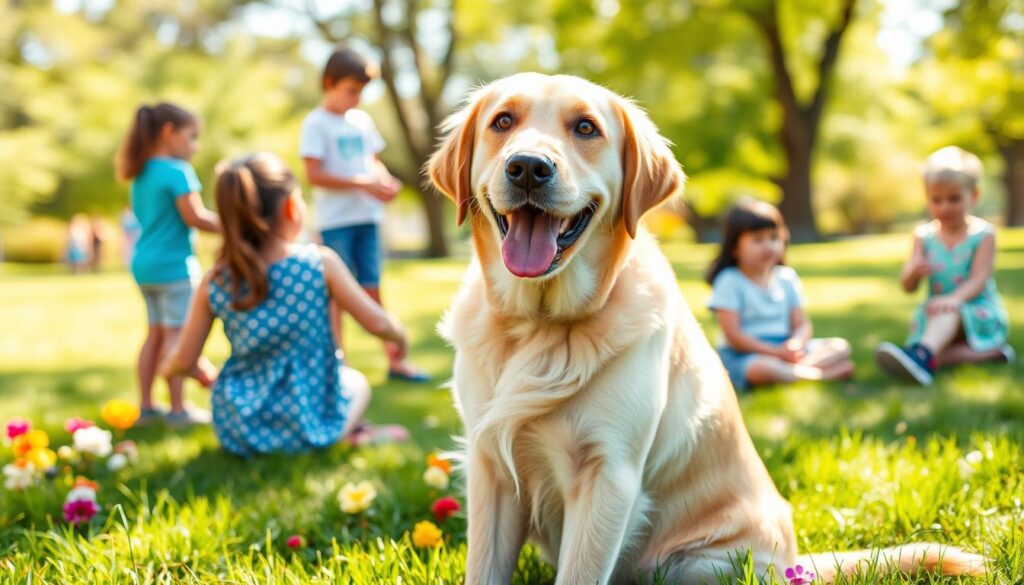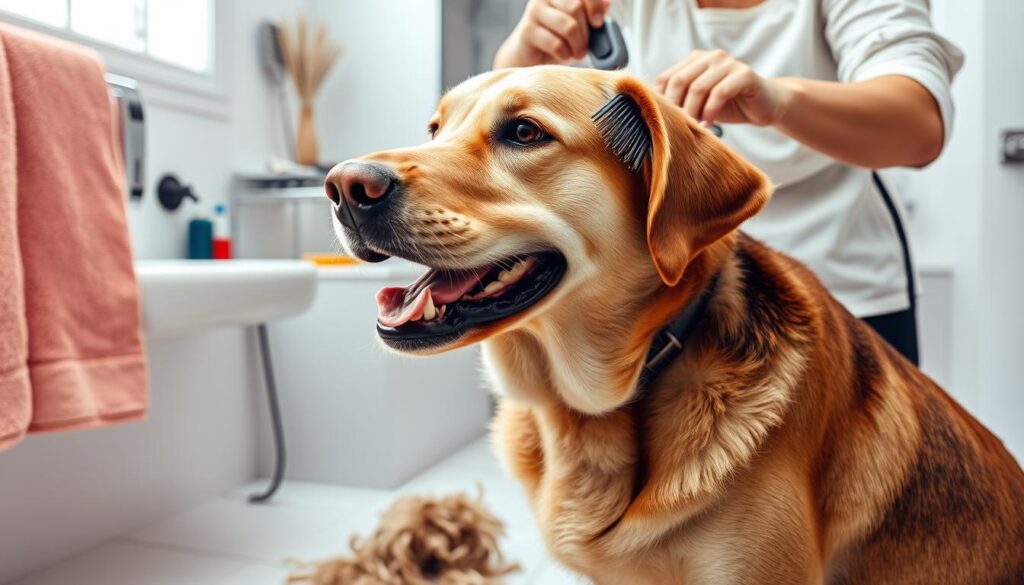Have you ever dreamed of a loyal, loving, and versatile dog to share your life with? Look no further than the Labrador Retriever! This beloved breed has won the hearts of families everywhere. They are among the most popular dogs in the United States and beyond.
Labradors are known for their friendly nature, intelligence, and adaptability. They make the perfect addition to any household.
Imagine coming home after a long day and your Labrador greets you with a wagging tail and a big, sloppy kiss. These gentle giants are affectionate and eager to please. They form strong bonds with their owners and the whole family.
Whether you have young children or love the outdoors, Labradors fit right in. They bring endless joy to any home.

Key Takeaways
- Labradors are one of the most popular dog breeds in the United States and worldwide
- They are known for their friendly, affectionate, and loyal personalities
- Labradors are highly adaptable and can thrive in a variety of living situations, from families with children to active outdoor enthusiasts
- This breed is intelligent and eager to please, making them easy to train and a great choice for first-time dog owners
- Labradors are versatile companions, excelling in various roles such as service dogs, hunting dogs, and family pets
Introduction to the Labrador Retriever Breed
The Labrador Retriever is a favorite among families around the world. They come from Newfoundland, Canada, and are known for their smarts and loyalty. These traits have made them a top choice in the United States and elsewhere.
Origins and History
In the 1800s, fishermen in Newfoundland started working with these dogs. They were great at swimming and retrieving games from the water. As time went on, the breed became more refined and was recognized by the Labrador Retriever Club and other kennel clubs.
Breed Recognition and Standards
The Labrador Retriever is well-known globally. The American Kennel Club (AKC) recognized them in 1917. Since then, they’ve been a top pick in the United States for over 30 years.
Why Labradors Make Perfect Family Companions
Labrador Retrievers are gentle, loving, and loyal. They’re smart, easy to train, and great with kids. They also live for about 10-12 years, offering lots of love and companionship.
Labradors are versatile, intelligent, and loving. They’re perfect for families looking for a loyal and dependable friend. Joining a Labrador Retriever club or getting one as a pet will surely bring joy and excitement to your life.
Physical Characteristics and Appearance
labrador retriever puppies are known for their unique looks. They have a sturdy build and a friendly face. This makes them a favorite among dog lovers everywhere.
Labradors are usually 22 to 24 inches tall and weigh 55 to 80 pounds. Males are a bit bigger than females. They have a thick double coat in black, chocolate, or yellow. This coat keeps them warm in different weather.
As labrador retriever puppies grow, they change a bit. They start round and playful. Later, they become lean and athletic, showing their hunting heritage. Their broad heads, gentle eyes, and strong tails stay the same.
There are two types of Labradors: American and English. The American Labrador is taller and leaner. The English Labrador is stockier and more compact. Both types show the breed’s great versatility and charm.

“The Labrador Retriever is a dog that looks as good as it acts.” – American Kennel Club
Labrador Retriever Temperament and Personality Traits
The labrador retriever is famous for its great temperament and loving nature. It’s a favorite among families in the United States. These smart dogs are loyal, gentle, and always eager to please.
Intelligence and Trainability
Labradors are very smart and easy to train. They love to learn and obey commands. With patience and positive feedback, they quickly learn new things and enjoy the challenge.
Social Nature and Family Compatibility
The labrador retriever is a top pick for families because of its friendly and social nature. They bond strongly with their families and are patient with kids. Their outgoing and loving personality makes them perfect for active homes.
Energy Levels and Exercise Needs
Labrador retrievers are full of energy and need lots of exercise. They need daily walks, playtime, and mental challenges to stay happy and healthy. While they love to relax, they can’t stand being idle for too long.
“The labrador retriever is the quintessential family dog, with a temperament that is truly unparalleled.”

Health Considerations for Your Labrador
The Labrador Retriever is a beloved dog breed known for its friendly nature and versatility. Yet, like any breed, they can face certain health issues. It’s important to know these concerns to give your dog the best care and a long, healthy life.
Hip dysplasia is a common problem in Labradors. It happens when the hip joint doesn’t form right. This can cause pain, and lameness, and lead to osteoarthritis. It’s key to have regular vet visits and screenings for hip and elbow dysplasia to catch it early.
Labradors are also at risk for eye problems like progressive retinal atrophy (PRA) and cataracts. These can slowly damage vision and even cause blindness. Responsible breeders test for these issues. Owners should also watch their Labrador’s eye health with vet check-ups.
Labradors usually live between 10 to 12 years, but some can live up to 14 with the right care. Genetics, diet, exercise, and lifestyle all play a part in how long a Labrador lives. Keeping up with vet visits, a balanced diet, and staying active are key to your Labrador’s health.
Knowing the health concerns of Labradors and taking steps to address them can ensure your dog lives a long, happy life. With the right care, your Labrador will be a loyal and loving family member for years.
Training Your Labrador Retriever
Training your Labrador Retriever is key to being a good pet owner. These smart dogs love to please and do well with structure and positive feedback. It’s important to be patient and understand your Labrador’s personality and needs.
Basic Obedience Training
Learning basic commands like sit, stay, and come is essential. Use rewards to teach these commands and to bond with your dog.
Socialization Tips
- Introduce your Labrador to many people, animals, and places early to help them adjust and feel confident.
- Sign up for puppy socialization classes or group training to help them make friends and learn social skills.
- Take your Labrador to dog-friendly spots like parks or pet stores to get used to new sights and sounds.
Advanced Training Opportunities
Labrador Retrievers can do more than just basic commands. They excel in agility, tracking, and competitive obedience. Joining a labrador retriever club can help you find these opportunities and bond with your dog.
| Training Activity | Benefits |
|---|---|
| Agility | Improves problem-solving, fitness, and confidence. |
| Tracking | Uses their natural hunting skills for mental exercise. |
| Competitive Obedience | Shows off their trainability and strengthens your bond. |

Training a Labrador Retriever should be fun and rewarding for both you and your dog. With patience, consistency, and a love for learning, you’ll raise a well-behaved and happy Labrador.
Grooming and Maintenance Requirements
Owning a labrador retriever means you’ll need to groom them regularly. These dogs are known for their lively and loving nature. They need attention to their coat, nails, and teeth to stay healthy and look good.
Labrador retrievers have a double coat. This coat is soft and dense under the surface and smooth and water-resistant on the outside. It helps them adjust to different climates but means they shed a lot, especially when the seasons change. Brushing their coat a few times a week helps manage shedding and keeps their fur shiny.
It’s also important to trim their nails regularly. This keeps their feet comfortable and healthy. Labradors are also prone to dental problems. Brushing their teeth a few times a week and getting professional cleanings can prevent these issues.
Grooming Tools and Techniques
To groom your Labrador, you’ll need a few tools. These include a sturdy brush, nail clippers, and dog-safe toothpaste and brushes. Learning the right grooming techniques is key to keeping your Labrador comfortable and safe.
- Invest in a high-quality slicker brush and rake to effectively remove loose fur and prevent matting.
- Use a gentle, circular motion when brushing to distribute natural oils throughout the coat.
- Trim your Labrador’s nails regularly, being careful not to cut them quickly (the blood vessel inside the nail).
- Introduce tooth brushing gradually, using positive reinforcement to make it a stress-free experience for your pup.
Grooming your Labrador retriever takes patience and practice. But it’s crucial for their health and happiness. By keeping up with their grooming, you’ll help your Labrador stay healthy and look their best.

Nutritional Needs and Feeding Guidelines
As a loving labrador retriever puppy owner, it’s key to know their special diet needs. Whether your pet is a growing puppy or an active adult, the right food is vital for their health and happiness.
Puppy Feeding Schedule
Labrador retriever puppies need more calories than adults because they grow fast. Feed them several small meals a day, about 3-4 times. This ensures they get all the nutrients they need.
- Puppies should eat high-quality, nutrient-rich puppy food until they’re 12-18 months old.
- Feed based on your puppy’s age, size, and how active they are, as the food maker suggests.
- Make sure your labrador retriever puppy always has fresh water to stay hydrated.
Adult Diet Requirements
When your labrador retriever grows up, their diet changes. Adults need a balanced diet to keep their energy and weight in check. Here’s how to feed your adult Labrador:
- Switch to high-quality adult dog food, following the recommended amounts for your dog’s size and activity level.
- Feed two or three meals a day instead of leaving food out all the time. This helps control their food intake and avoid obesity.
- Add different protein sources like chicken, beef, or fish to make sure your Labrador gets a complete diet.
Common Food Allergies
Labrador retrievers might have food allergies, leading to digestive problems, skin issues, or other health issues. Common allergens include:
- Grains like wheat, corn, or soy
- Dairy products
- Certain proteins, such as beef or chicken
If you think your labrador retriever has a food allergy, talk to your vet. They can help find the best hypoallergenic diet for your pet.
Exercise Requirements and Activities
Labrador retrievers are full of energy and love to stay active. They need lots of exercise every day to stay happy and healthy. It’s important to make sure they get enough physical activity.
These dogs are always ready for fun and need a mix of physical and mental challenges. Try to give them at least an hour of exercise each day. This can include walks, runs, fetch, and more to keep them engaged.
Recommended Exercise Activities for Labradors
- Brisk walks or jogs: Labradors love to explore the great outdoors and will happily accompany you on long walks or runs.
- Fetch and retrieve games: These intelligent pups excel at retrieving games, which provide both physical and mental stimulation.
- Swimming: Labrador retrievers are natural-born swimmers and love to splash around in the water.
- Agility training: Obstacle courses and agility training can be an excellent way to challenge your Labrador’s mind and body.
- Outdoor playtime: Letting your Labrador run freely in a secure, fenced-in area allows them to burn off energy and play.
A well-exercised labrador retriever is a happy and well-behaved one. Meeting their exercise needs keeps them healthy and prevents bad behavior. This is because they won’t get bored or have too much energy.
| Exercise Recommendation | Duration |
|---|---|
| Daily Walks or Jogs | 30-60 minutes |
| Fetch and Retrieve Games | 15-30 minutes |
| Swimming | 30 minutes |
| Agility Training | 15-30 minutes |
| Outdoor Playtime | 30 minutes |
By mixing up these exercises in your Labrador’s daily routine, you’ll meet their physical and mental needs. This leads to a happier, healthier, and better-behaved pet.
Choosing Your Labrador Puppy
Choosing the perfect Labrador Retriever puppy is exciting and important. Think about the breeder’s reputation, the puppy’s temperament, and your lifestyle and budget. Good Labrador breeders often have long waiting lists because these dogs are so popular.
The average cost of a Labrador Retriever can be between $800 and $1,500. This price depends on the breeder’s location, the puppy’s bloodline, and any special training or certifications.
Adopting a Labrador from a rescue is another option. Rescue Labradors are usually spayed or neutered and cost less, around $300 to $500. No matter your choice, be ready for the costs of owning a Labrador. This includes food, supplies, vet bills, and training.
After finding your perfect Labrador puppy, prepare your home and introduce them to your family. Please give them a cozy spot, lots of toys, and consistent training. With patience and love, your Labrador will become a loyal friend for many years.
labrador insurance – How much does a Labrador cost in the UK?
FAQ
What is a Labrador Retriever?
The Labrador Retriever is a popular dog breed. They are known for being friendly, smart, and versatile. Originating in Newfoundland, Canada, they make great family pets because of their loyalty and gentle nature.
How long do Labrador Retrievers live?
Labradors usually live between 10 to 12 years. Some may live up to 14 years with the right care. This makes them a great choice for families looking for a long-term pet.
How much do Labrador Retriever puppies cost?
Labrador puppies can cost between $800 to $1,500. The price depends on the breeder, the puppy’s lineage, and where you live. It’s important to find a responsible breeder or rescue to get a healthy puppy.
What are the physical characteristics of a Labrador Retriever?
Labradors are medium-sized with a strong build. They have a short, dense coat of black, yellow, or chocolate. They are known for their otter-like tail, webbed feet, and friendly face.
What is the Labrador Retriever’s temperament like?
Labradors are friendly, outgoing, and smart. They are easy to train and love to please. They are great with families and children, making them excellent companions.
How much exercise do Labrador Retrievers need?
Labradors need lots of exercise and mental stimulation. They need at least 30-60 minutes of activity daily. This can include walks, playtime, and swimming. It’s important for their health and behavior.
How do I train a Labrador Retriever?
Labradors respond well to positive training. Start with basic commands and socialization. Building a strong bond is key. Many clubs and organizations offer training classes and resources.
What are the common health issues in Labrador Retrievers?
Labradors can get hip and elbow dysplasia, eye problems, and obesity. Getting them from a responsible breeder and regular vet visits can help prevent these issues. This ensures they live a long, healthy life.




